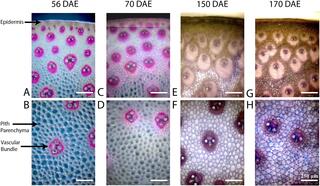Analysis reveals causes of threefold increase in bioenergy sorghum stem density

Background/Objective
Bioenergy sorghum is a drought-tolerant, low-input grass adapted low-productivity lands that promotes soil carbon stocks. An extended vegetative growth phase and long growing season produce high yield and 4-5 m stems that account for about 80% of shoot biomass. Scientists found that during a typical growing season stem density increases significantly following stem internode growth, although the basis of density change was unknown.
Approach
To better understand variation in stem composition, scientists used microscopy, composition, and transcriptome analysis to characterize the basis of increased stem density.
Results
The study found that a threefold increase in stem density was primarily due to accumulation of cellulose, glucuronoarabinoxylan, and lignin for more than 30 days following the completion of internode growth. Transcriptome analysis showed expression of genes involved in cell wall biosynthesis remains high during stem densification, although expression of genes involved in secondary cell wall formation decreases in the stem core shortly after elongation is complete.
Impact
Continued cell wall biosynthesis in elongated stems increases mechanical strength and bulk density but also alters biomass composition, which could affect the amount and release of cellulosic sugars and lignin-derived bioproducts. These results suggest it would be best to assess saccharification efficiency at the end of the growing season when stem density is highest. Down-regulation of stem cell wall biosynthesis may increase the accumulation of value-added products in sorghum stems.
Yu, K. M. J., et al., Bioenergy sorghum stem density increases threefold following internode elongation due to continued accumulation of lignified cell walls and complex regulation of genes involved in cell wall biosynthesis. Biotechnology for Biofuels and Bioproducts, 18, 58. (2025). [DOI:10.1186/s13068-025-02659-w]